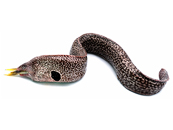American Eel
Anguilla rostrata
AKA: Freshwater eel
Eels can be a great catch for anglers, but are not a particularly popular catch. There are nearly 400 different species of eels.
-
Distinguishing Markings:
The American eel has a slender snakelike body with very small scales, often making it appear naked. A long dorsal fin usually extends for more than half the length of the body and is continuous with a similar ventral fin. Pelvic fins are absent. The back may be olive-green to brown shading to greenish-yellow on the sides and light gray or white on the belly.
-
Size:
Female eels grow larger than the males, nearly three feet, although some have been reported to reach five feet. Male eels do not grow longer than 1.5 feet. The world record is 9.25 pounds.
Distribution:
The American eel occurs in a variety of habitats from Greenland to Brazil and probably spans a wider range of latitudes than any other species in North America. American eels occur profusely in the Mississippi’s tributaries, including the Minnesota, Saint Lawrence Seaway, Saint Croix rivers, and sometimes in Lake Superior. Freshwater Females Eels swim all the way up the Mississippi River from the Gulf of Mexico to reach Minnesota for reproduction. They range as far west as New Mexico, and are common throughout the Caribbean and the West Indies.
-
Habitat:
When eels are not migrating, it is easy to find them in medium to large size lakes and streams with quiet waters and muddy bottoms. Eels are more active at night, so they need the mud or underwater objects to be hidden during the day.
-
Food:
Freshwater American eels are predators that feed at night, usually on all types of meat including insects, frogs, crayfish, snails, fish, and earthworms.
-
Spawning:
Adult eels spend most of their lives in freshwater, although they spawn during the winter in the Sargasso Sea, a tropical area northeast of Cuba. At some point, adults leave their freshwater habitats and move toward the Sargasso Sea. Neither adults nor eggs have been collected in the vicinity of the Sargasso Sea, but newly hatched eels are found there. Young eels are transparent and leaf shaped. Within about a year, growing and moving toward the mainland, eels transform into more eel-like forms, about six inches long, called glass eels or elvers and are ready to enter freshwater. They begin to develop coloration as they reach nearshore areas, and, once they reach freshwater, females continue to migrate deep inland as far up rivers and tributaries as they can. Males remain much closer to coastline areas.
American eels are long lived; captive eels have been reported to live as long as 88 years. In the wild, the is no evidence of how long freshwater eels live, but females spend from 10 to 20 years in the American rivers to mature and then they return to the oceans or die after breeding once.
-
Fishing Tips:
In the eastern United States, the American eels are harvested commercially. Many anglers are put off by the snake-like appearance of eels and the prodigious amounts of slime they produce when captured. Most eels are caught by anglers fishing for something else.

